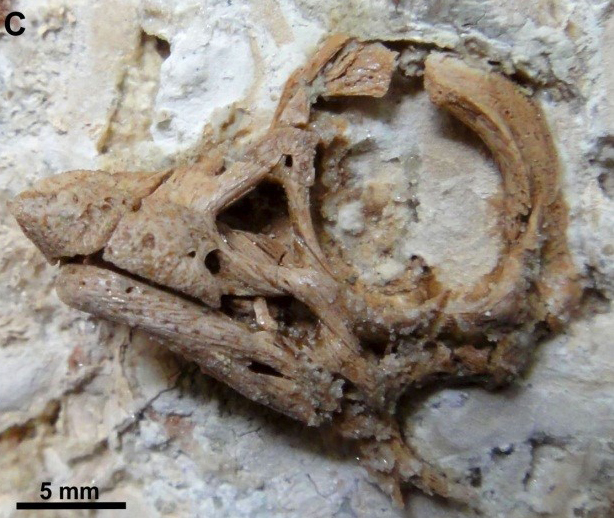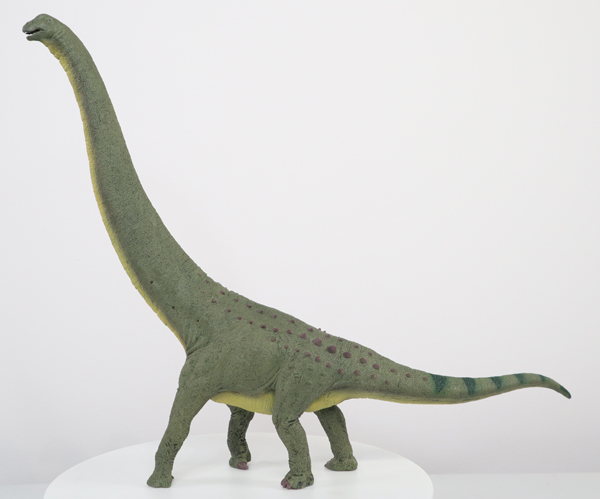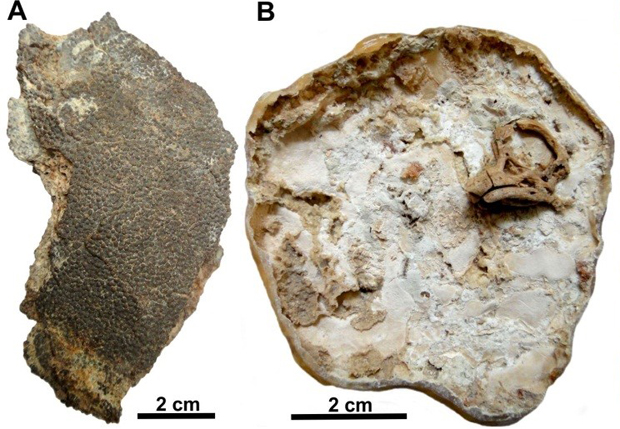Baby Sauropods had Rhino-like Horns
Horned Baby Dinosaurs But Not a Ceratopsian in Sight!
A team of international researchers have published a new scientific paper that reports on the discovery of a beautifully preserved embryo of a dinosaur. The fossil specimen representing a titanosaur, that lived around 80 million years ago, has permitted palaeontologists to demonstrate that these herbivores had stereoscopic vision, just like most of the carnivorous dinosaurs that would have hunted them. Furthermore, the embryonic skull has revealed that these sauropods had small horns on the front of the face, which they later lost as they grew up.
A Close-up View of the Embryonic Titanosaur Skull

Picture credit: The University of Manchester
An Amazing Fossil Discovery
The research team, which included Dr John Nudds (Manchester University), state that this is the most complete and articulate skull known from any titanosaur, a group of temporally and geographically diverse sauropods, members of which evolved into some of the largest land animals that ever existed. The egg fossil was discovered in southern Argentina (Patagonia) and heralds from strata laid down during the Cretaceous (Campanian faunal stage of the Late Cretaceous).
A Model of a South American Titanosaur – Dreadnoughtus

Picture credit: Everything Dinosaur
The image (above) show a titanosaur figure in the CollectA Deluxe range.
To view this range of models: CollectA Deluxe Prehistoric Life Models.
It was imperative the egg was repatriated to Argentina however as it is illegal to permanently remove fossils from the country.
Commenting on the significance of the fossil discovery, Dr John Nudds (Manchester University) stated:
“The preservation of embryonic dinosaurs preserved inside their eggs is extremely rare. Imagine the huge sauropods from Jurassic Park and consider that the tiny skulls of their babies, still inside their eggs, are just a couple of centimetres long. We were able to reconstruct the embryonic skull prior to hatching. The embryos possessed a specialised craniofacial anatomy that precedes the post-natal transformation of the skull in adult sauropods. Part of the skull of these embryonic sauropods was extended into an elongated snout or horn, so that they possessed a peculiarly shaped face.”
Revising Opinions About Baby Dinosaur Anatomy
The analysis of the fossil specimen allowed the research team to revise opinions on how babies of these huge dinosaur might hatch and to test previously held ideas about sauropodomorph reproduction. The elongated facial horn may have been used as an “egg tooth” to help the babies to break out of their eggs.
New Study Tests Ideas about Sauropodomorph Reproduction
Picture credit: The University of Manchester
The paper has been published today in the academic journal “Current Biology”. The fossilised bones of the embryo were revealed by dissolving the matrix using an acid preparation. The researchers were able to perform a virtual dissection of the fossil material by bombarding the specimen with powerful X-rays to build up a three-dimensional image. The European Synchrotron Radiation Facility (ESRF) at Grenoble was employed for this purpose.
Dinosaur Embryology and Baby Sauropods
Dinosaur embryology remains one of the least explored and poorly understood areas of research when it comes to the Dinosauria. Argentina has provided palaeontologists with evidence of titanosaur nesting sites and embryos before, most famously the nest sites discovered in northern Patagonia associated with Saltasaurus loricatus that were studied by the famous Argentinian palaeontologist José Bonaparte. Saltasaurus was named and described in 1980, the first titanosaur to be named from South America. Since then, many more genera have been erected including Argentinosaurus, Andesaurus, Barrosasaurus, Bonatitan, Dreadnoughtus and Futalognkosaurus.
However, this is the first time a fully intact embryo has been studied. Other fossilised eggs are also known from this site, the scientists hope to repeat their work with other specimens and are optimistic that some of the eggs might even retain the preserved remains of dinosaur skin.
The scientific paper, “Specialized Craniofacial Anatomy of a Titanosaurian Embryo from Argentina” is published in Current Biology. The lead author on the paper is Martin Kundrat, Evolutionary Biodiversity Research Group Pavol Jozef Šafárik University.
The Everything Dinosaur website: Everything Dinosaur.


